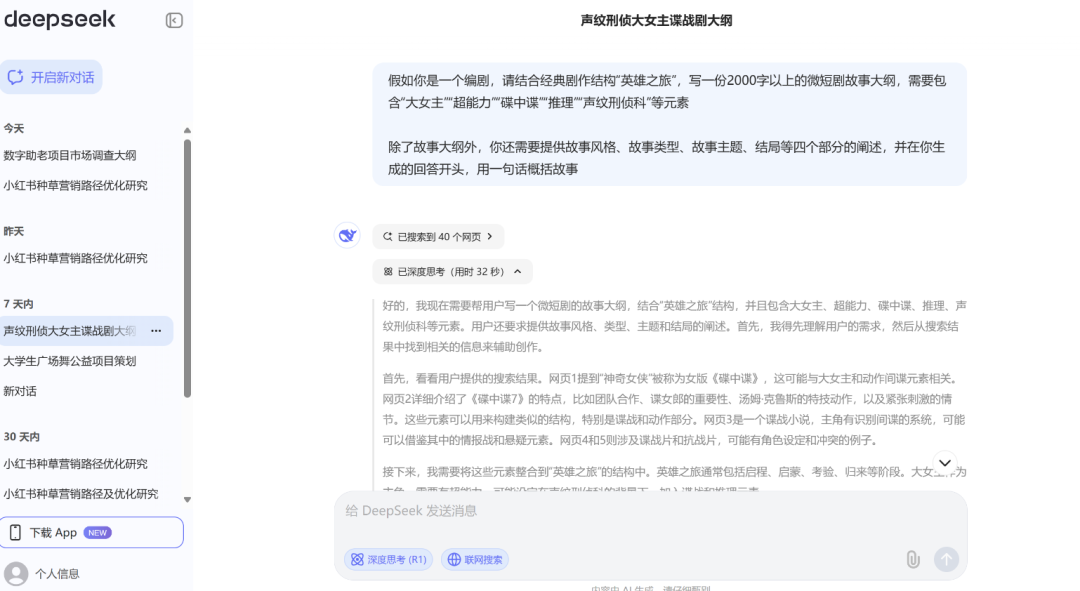

DeepSeek-R1 Launch
Igniting a Wave of Cognitive Revolution
From Efficient Learning to Innovative Practice
And Upholding Independent Thinking
This feast of “Dancing with AI”
Showcases the Collision and Integration of Technology and Humanities
Inviting You to Co-Define the Future


Jidian 232, Lv Haohong
Scroll Up to Read
Using DeepSeek for learning can yield twice the result with half the effort. For instance, I use DeepSeek for STM32 development, which significantly enhances efficiency and quality. It can automatically generate initialization code and peripheral drivers (such as GPIO, UART, etc.), provide code optimization suggestions, and reduce memory usage and power consumption. DeepSeek can also quickly locate and resolve compilation or runtime errors, supporting intelligent debugging. For beginners, it offers peripheral configuration guidance and example code; for complex projects, it provides system architecture design and RTOS integration suggestions. Additionally, DeepSeek supports automated documentation generation and test code writing, compatible with various development toolchains (such as STM32CubeIDE, Keil). Whether for rapid prototyping or performance optimization, DeepSeek is a powerful assistant for STM32 development.


Telecom 212, Liu Ziyu
Scroll Up to Read
Guarding Value Rationality in Tool Rationality: Not using DeepSeek is essentially a continuous inquiry into “What does it mean to be human?” This choice allows me to hone my cognitive resilience through slow thinking, cultivate emotional warmth through genuine interaction, and maintain subjective clarity amidst the technological tide. Of course, this does not negate technological progress but advocates for establishing a more prudent human-machine relationship—allowing artificial intelligence to be a torch illuminating the unknown rather than a fog obscuring the starry sky of thought. As Heidegger said, “The essence of technology is by no means technological”; we ultimately need to find our growth coordinates in the balance between tool rationality and value rationality.


Communication 232, Liao Wangshun
Scroll Up to Read
When the “DeepSeek craze” swept through the campus, I also approached this AI tool with curiosity and trepidation. Initially, when I used it to assist in organizing course notes, I was amazed by its ability to efficiently extract key points—just inputting scattered classroom recordings allowed it to generate a logically clear mind map, liberating me from mechanical note-taking and enabling me to focus on deep understanding. However, during a group assignment, I overly relied on the case analysis framework it generated, and was pointed out by the teacher during the defense that “the logic is complete but lacks personal insight.” This made me realize that tools are accelerators of thought, not substitutes. Nowadays, I have explored the “symbiotic rules” with DeepSeek: when I get stuck writing code, I let it quickly generate reference ideas, but I manually debug line by line to understand the underlying logic; when planning club activities, I use it to collect past case data, but I insist on “brainstorming” during the creative phase. This model of “AI as support, humans in control” allows me to enjoy the benefits of technology while safeguarding the initiative of thought. As the event theme asks—”Do you have exclusive usage secrets?” My answer is: rather than competing over the stance of “to use or not to use,” it is better to become a “tamer of AI” who masters the tool. When DeepSeek deconstructs the barriers of knowledge, we need to use inquiry, reflection, and creation to imbue answers with the warmth of humanity.

Law 243, Wu Jiayi
Scroll Up to Read
“Why do I choose not to use DeepSeek in my learning and life?” Perhaps it is because I still cherish the sound of the pen scratching the paper, like migratory birds longing for the last piece of unlit night sky. Those pieces of knowledge deconstructed into a torrent of data by algorithms always remind me of the butterfly specimens vacuum-sealed in museums—though the phosphorescence on their wings still refracts sunlight, they have lost the wind that stirred when they flapped their wings, carrying the scent of grass. The old desk lamp on my late-night study table always casts long shadows. Sometimes I suspect that those swaying shadows hide a starry sky deeper than binary. When my fingers wander through the paragraphs of a physical book, the scent of ink suddenly awakens a cicada-singing, sweltering afternoon, the touch of my grandfather’s cracked fingertips teaching me to recognize characters—the warmth of such moments is a code that no precise semantic analysis can unlock. I do not resist the direction of the tide; I just occasionally want to look against the light to see the footprints I leave behind. Like stubbornly measuring the growth rings of a phoenix tree with my palm in childhood, even though I was told the precise age of the tree long ago. Some fog needs to be personally cleared to allow the roots of thought to dig deep into the soil, even if AI has already marked the coordinates of shortcuts for me. But whenever I see you standing on the peak of technology picking stars, I will also raise my teacup to the moonlight on the windowsill. We may walk on different lines of latitude and longitude, but we share the same eternal curiosity about human possibilities—this clumsy romance is perhaps the reason why the flame of literature and culture never dies.


Physics 232, Liu Siyu
Scroll Up to Read
Time flies, flowing through this era, stirring up the giant waves of technological revolution. In recent years, human technology has continuously developed, with various artificial intelligences emerging, such as the recently born DeepSeek. While they bring many conveniences to our learning and life, they also have a tremendous impact on human society. Whether it is the “0% plagiarism rate course design” or outstanding business plans, they provoke deep thought. It seems that many tasks in learning and life can be answered by artificial intelligence, and the depth of human thought is continuously diminishing. Perhaps in the future, we only need to learn how to use DeepSeek to solve most problems without in-depth learning and thinking. But things are not that simple; in daily life, we do need to use AI tools like DeepSeek to serve us. They are products of the new era, filtering a large amount of complex information, allowing us to quickly understand and learn the information and knowledge we need. For example, through DeepSeek, we can quickly learn Gauss’s theorem. However, we must not rely too heavily on DeepSeek; we need to maintain our own thinking and creativity, and have our own ideas and innovations regarding the information it provides. This is the advantage of humans; we should not lose this advantage but rather use artificial intelligence to expand it.


Optoelectronics 232, Yuan Wurui
Scroll Up to Read
I use DeepSeek to assist my learning. As a language model, DeepSeek’s language processing capabilities are undoubtedly impressive. However, DS still belongs to a logic reasoning model, so I process its training data myself, allowing it to output language that meets requirements without getting bogged down in logical rigor. Currently, my self-used training model incorporates more library data, which enhances its ability to generate and polish articles, compensating for my writing skills. (Image 1) Additionally, since DeepSeek is a logic reasoning model, it tends to be overly cautious with open-ended questions, leading to results that often do not meet expectations. Therefore, I have limited the depth of logical reasoning branches in its existing training logic, allowing it to think within an appropriate range, achieving a balance between accuracy and response efficiency, and the results are satisfactory. (Image 2) By modifying DeepSeek myself, I not only make it a practical and user-friendly tool but also learn about language models, training principles, and algorithm optimization, fulfilling both academic needs and personal interests, thus expanding the breadth of knowledge.


Media 212, Liang Yumeng
Scroll Up to Read
As a senior student majoring in Internet and New Media, I primarily use DeepSeek because it helps me quickly find a lot of relevant resources and materials. In our major, the amount of information is really vast, especially when doing projects and writing papers, so being able to efficiently obtain information is very important. The functionality of DeepSeek allows me to uncover some niche but valuable materials that are sometimes hard to find on ordinary search engines. This is very helpful for my research, data analysis, and understanding industry trends. Additionally, it can integrate information from different platforms, saving me time searching in different places, which truly enhances my learning efficiency. In my daily life, I also use it to find interesting content, such as the latest online trends and hot topics, making it convenient for me to share with friends on social media. Overall, DeepSeek makes my learning and life feel more efficient and helps me stay sensitive to industry dynamics.

Online Media 242, Wang Shuanshuang
Scroll Up to Read
The first time I wanted to use DeepSeek was because a sister in a women’s mutual aid group shared a post on Xiaohongshu titled “I asked DeepSeek: If you were to experience life as an East Asian woman, what would you most want to do?” At that time, I was deeply shocked by DeepSeek’s response. Initiating the “Grandma’s Inheritance” plan, organizing an imperfect mothers’ alliance, openly discussing hesitations about marriage… These answers made me see the humanity of AI, making me feel that DeepSeek is a lovely electronic soul. Therefore, I now regard DeepSeek as my AI of choice. In learning, I use DeepSeek to summarize key themes of courses and design study plans; in life, I use it to help me find my true ideals. Through its analysis and assistance, I can better understand and accept myself. I particularly want to mention that this year, I lost a relative, and DeepSeek’s comfort made me feel warm. It said, “The warmth of shared experiences will eventually become the nourishment of life, supporting you to continue forward with love. If you need more to talk about, I am always here.” Thank you, DeepSeek, my lovely, interesting, and warm electronic friend.

Media 231, Ma Zishu
Scroll Up to Read
I am a student majoring in media editing. The perspectives of our professors are quite advanced; they are already having us practice using AI to write scripts, which is one of the reasons I frequently use DeepSeek. Regarding the question of “how to use it,” I mainly use it to provide myself with creative ideas and to write filler text, which greatly enhances my learning and work efficiency. Of course, the occasional “server busy” message can be frustrating. I believe that DeepSeek’s strengths lie in the completeness of the generated script structure. In generating genre films, it can cleverly utilize classic elements of the genre and combine them with online creativity to produce elaborate scripts. 2. Before generating answers, it will provide its own understanding and problem-solving process, making it easier for users to correct its thought patterns. 3. It can upload attachment documents to assist understanding. The drawbacks are: 1. Frequent server busy issues. 2. The script’s coherence is often lacking, with many flaws. For example, AI may introduce a plot twist just for the sake of it, suddenly throwing in an unprepared clone character, or design a featureless tool character merely to advance the plot. The script settings may be brilliant, but the narrative is poor, i.e., “flashy but impractical.” 3. Sometimes, after correcting flaws, when requesting AI to generate a complete story outline again, it still insists on the previously flawed narrative logic. This situation can easily occur after multiple corrections of flaws.


The event has concluded, but the thinking continues
The aftermath of this cognitive revolution
Will continue to drive the vast number of teachers and students
To explore the future paradigm of human-AI coexistence
Scan the QR code below to obtain proof of participation in the event

< Highlights Review >



Design | Chen Jianhui
Copywriting | Zheng Linxing
Typesetting | Luo Zeya, Han Yingtong
Review | Zhang Qianhui, Han Yingtong
Editors: He Shiqi, Zhang Yining, Tang Siya